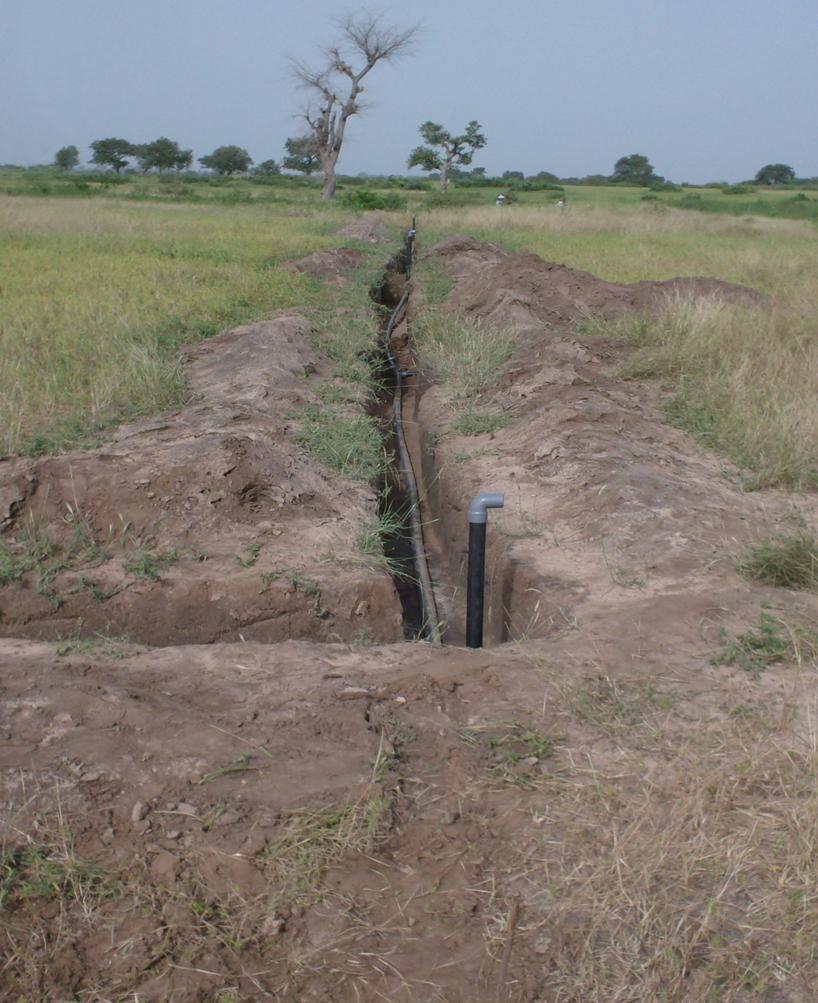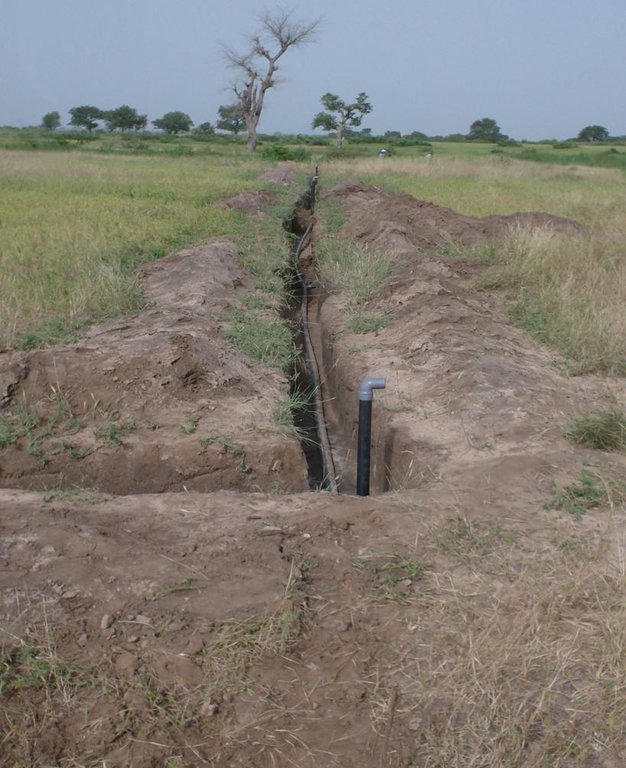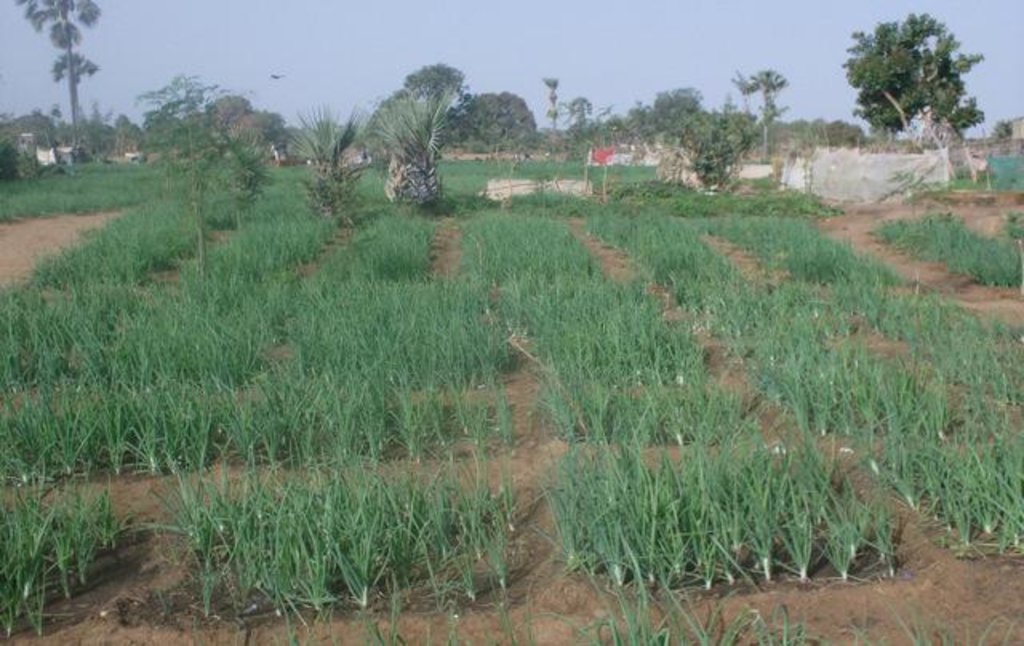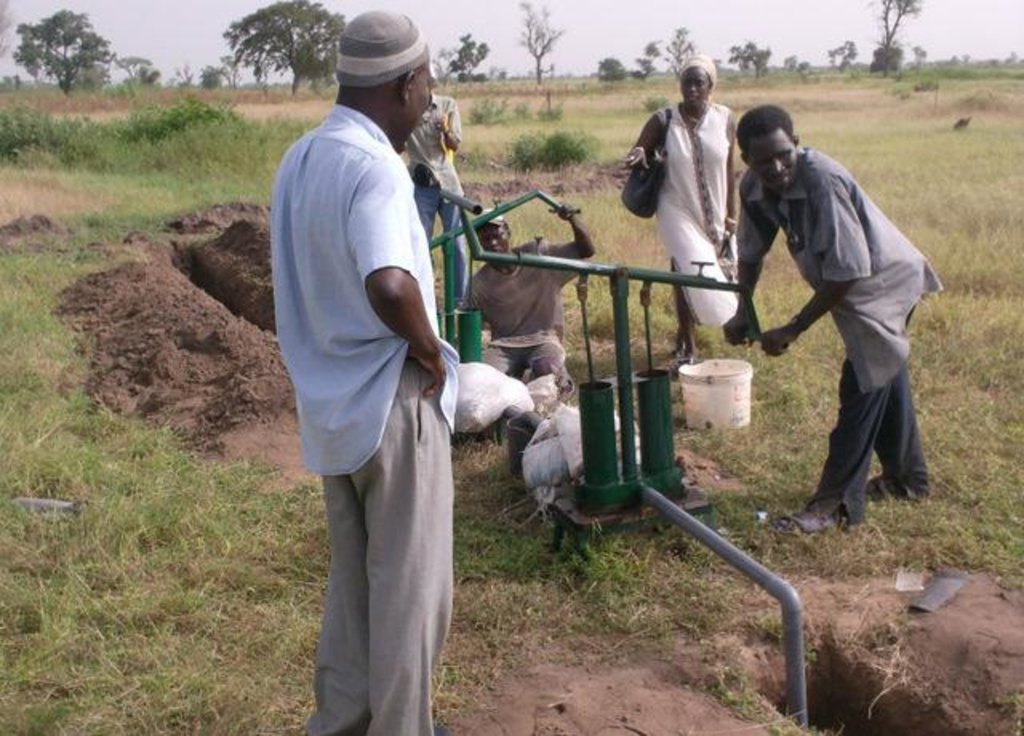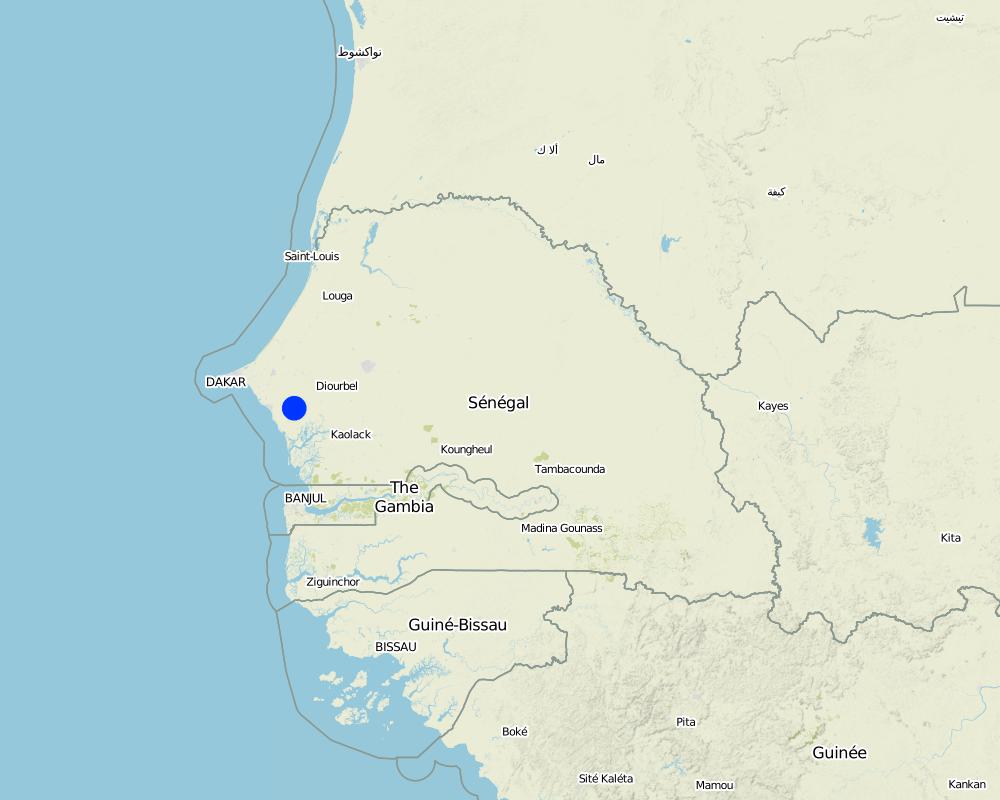Low-Pressure Irrigation System ‘Californian’ [塞内加尔]
- 创建:
- 更新:
- 编制者: Julie Zähringer
- 编辑者: –
- 审查者: Alexandra Gavilano, Fabian Ottiger
technologies_946 - 塞内加尔
查看章节
全部展开 全部收起1. 一般信息
1.2 参与该技术评估和文件编制的资源人员和机构的联系方式
有助于对技术进行记录/评估的项目名称(如相关)
Book project: SLM in Practice - Guidelines and Best Practices for Sub-Saharan Africa (SLM in Practice)有助于对技术进行记录/评估的机构名称(如相关)
FAO Food and Agriculture Organization (FAO Food and Agriculture Organization) - 意大利1.3 关于使用通过WOCAT记录的数据的条件
编制者和关键资源人员接受有关使用通过WOCAT记录数据的条件。:
是
2. SLM技术的说明
2.1 技术简介
技术定义:
The low pressure pipe distribution system called ‘Californian’ has proven to be a very efficient irrigation system for small-holder farmers group in Africa.
2.2 技术的详细说明
说明:
The principle of the Californian system is to convey water to the crops through fixed underground rigid PVC pipes (40–75 mm diameter). The pipe network is buried at 0.50 m depth to avoid deterioration by UV radiation and agricultural practices. Risers with hydrants are fixed to those rigid pipes at regular distance (18-36 m). To each riser a 14 m long flexible hose is attached which can be dragged around to irrigate the individual plots and crops. The installation of the pipe network can be made locally by plumbers. Water is supplied through a pump (manual, pedal or small motor) from a well, a reservoir or a river. From the intake water is conveyed to the highest point of the plot which allows the conveyance to the field’s most distant point (irrespective of topographical conditions - upslope or downslope).
The system is remarkably efficient in sandy or salty soils. It is adapted to small–scale farming especially for vegetable crops, rice and tree crops and is suitable for areas ranging between 0.25 - 1 ha; one riser irrigates an area of 500-1000 m2. The system as such does not require maintenance. In case of deterioration of pipes or fittings, the farmer can easily fix the problem himself or with the assistance of a local plumber. The estimated life expectancy for the Californian system is 6-10 years in West African conditions. Ideal conditions for transfer / adoption of the technology include: (1) Availability of shallow aquifers, and other water sources; (2) Occurrence of sandy soils and sandy clay soils; (3) Clearly defined land legislation and tenure; (4) Access to markets and to microfinance institutions.
Establishment / maintenance activities and inputs: Establishment activities for this technology are the following: 1. Layout of pipe network by putting stakes along the line to indicate the orientation of the canal to be dug. 2. Excavate network of canals (0.2 m wide, 0.5 m deep; straight and regular). In sandy soil the interval between risers is 30m x 18m or 36m x 18m (intervals are multiples of 6 m = PVC pipe unit length). Density of risers is 10 -15 risers / ha.
3. Install the pipes into the open canals, fittings are assembled by sticking. 4.Install hydrants composed by a 0.2 m high riser, a PVC elbow and a locally made flow control device (plug); the risers are anchored in the soil through a small concrete slab.
5. Put the pipe under flow condition to verify the water tightness of the system. 6. Bury the canals. 7. Protect risers from sun. Regarding maintenance of the system the following is important: 1.Before starting to pump it is recommended to let open one of the hydrants in order to avoid excessive pressure and blasting of pipes. 2. In case of deterioration of the pipes or fittings, land users can easily fx the problem themselves or request the intervention of a local plumber.
2.3 技术照片
2.5 已应用该技术的、本评估所涵盖的国家/地区/地点
国家:
塞内加尔
区域/州/省:
Diourbel
有关地点的进一步说明:
Diourbel, Baba garage village
Map
×2.6 实施日期
如果不知道确切的年份,请说明大概的日期:
- 不到10年前(最近)
2.7 技术介绍
详细说明该技术是如何引入的:
- 通过项目/外部干预
3. SLM技术的分类
3.1 该技术的主要目的
- 改良生产
- 减少、预防、恢复土地退化
- 创造有益的经济影响
3.2 应用该技术的当前土地利用类型

农田
- 一年一作
3.4 供水
该技术所应用土地的供水:
- 雨养
3.5 该技术所属的SLM组
- 灌溉管理(包括供水、排水)
- 引水和排水
3.6 包含该技术的可持续土地管理措施

农艺措施
- A7:其它
3.7 该技术强调的主要土地退化类型

水质恶化
- Hg:地下水/含水层水位的变化
注释:
Main type of degradation addressed: Hg: change in groundwater / aquifer level
3.8 防止、减少或恢复土地退化
具体数量名该技术与土地退化有关的目标:
- 防止土地退化
4. 技术规范、实施活动、投入和成本
4.1 该技术的技术图纸
技术规范(与技术图纸相关):
Dimensions and main components of the low-pressure irrigation system: (1) water source; (2) manual or motor pump; (3) input hydrant; (4) rigid PVC pipes; (5) small concrete slab; (6) elbow; (7) plug; (8) flexible hose for irrigation
Technical knowledge required for field staff / advisors: high (Technical assistance needed for design, installation and operation of the system; installation of pipes is quick and easy; no need for topographical survey)
Technical knowledge required for land users: high
Main technical functions: water harvesting / increase water supply, water spreading
Agronomic measure: low pressure irrigation
4.3 技术建立活动
| 活动 | 时间(季度) | |
|---|---|---|
| 1. | Layout of pipe network by putting stakes along the line to indicate the orientation of the canal | |
| 2. | Excavate network of canals (0.2 m wide, 0.5 m deep; straight and regular). In sandy soil the inte | |
| 3. | Install the pipes into the open canals, fittings are assembled by sticking | |
| 4. | Install hydrants composed by a 0.2 m high riser, a PVC elbow and a locally made flow control devi | |
| 5. | Put the pipe under flow condition to verify the water tightness of the system | |
| 6. | Bury the canals | |
| 7. | Protect risers from sun |
4.4 技术建立所需要的费用和投入
| 对投入进行具体说明 | 单位 | 数量 | 单位成本 | 每项投入的总成本 | 土地使用者承担的成本% | |
|---|---|---|---|---|---|---|
| 劳动力 | Labour | ha | 1.0 | 50.0 | 50.0 | |
| 施工材料 | None | None | ||||
| 施工材料 | PVC | ha | 1.0 | 1333.0 | 1333.0 | |
| 技术建立所需总成本 | 1383.0 | |||||
| 技术建立总成本,美元 | 1383.0 | |||||
4.5 维护/经常性活动
| 活动 | 时间/频率 | |
|---|---|---|
| 1. | Before starting to pump it is recommended to let open one of the hydrants in order to avoid excessive pressure and blasting of pipes | |
| 2. | In case of deterioration of the pipes or fittings, land users can easily fix the problem themselves or request the intervention of a local plumber |
4.7 影响成本的最重要因素
描述影响成本的最决定性因素:
If soil is not sandy labour input for establishment increases. Hand or treadle pumps are provided by the project. Motor pumps (with pump capacity 2 HP) increase costs for establishment and maintenance (fuel) but reduce labour inputs for operation.
5. 自然和人文环境
5.1 气候
年降雨量
- < 250毫米
- 251-500毫米
- 501-750毫米
- 751-1,000毫米
- 1,001-1,500毫米
- 1,501-2,000毫米
- 2,001-3,000毫米
- 3,001-4,000毫米
- > 4,000毫米
指定年平均降雨量(若已知),单位为mm:
450.00
有关降雨的规范/注释:
9 months dry period
农业气候带
- 半干旱
Thermal climate class: tropics
5.2 地形
平均坡度:
- 水平(0-2%)
- 缓降(3-5%)
- 平缓(6-10%)
- 滚坡(11-15%)
- 崎岖(16-30%)
- 陡峭(31-60%)
- 非常陡峭(>60%)
地形:
- 高原/平原
- 山脊
- 山坡
- 山地斜坡
- 麓坡
- 谷底
垂直分布带:
- 0-100 m a.s.l.
- 101-500 m a.s.l.
- 501-1,000 m a.s.l.
- 1,001-1,500 m a.s.l.
- 1,501-2,000 m a.s.l.
- 2,001-2,500 m a.s.l.
- 2,501-3,000 m a.s.l.
- 3,001-4,000 m a.s.l.
- > 4,000 m a.s.l.
5.3 土壤
平均土层深度:
- 非常浅(0-20厘米)
- 浅(21-50厘米)
- 中等深度(51-80厘米)
- 深(81-120厘米)
- 非常深(> 120厘米)
土壤质地(表土):
- 粗粒/轻(砂质)
表土有机质:
- 低(<1%)
如有可能,附上完整的土壤描述或具体说明可用的信息,例如土壤类型、土壤酸碱度、阳离子交换能力、氮、盐度等。:
Soil fertility: Low
Soil drainage/infiltration: Good
Soil water storage capacity: Low
5.4 水资源可用性和质量
地表水的可用性:
好
5.6 应用该技术的土地使用者的特征
生产系统的市场定位:
- 混合(生计/商业)
个人或集体:
- 个人/家庭
机械化水平:
- 手工作业
- 畜力牵引
说明土地使用者的其他有关特征:
Land users applying the Technology are mainly disadvantaged land users
5.7 应用该技术的土地使用者使用的平均土地面积
- < 0.5 公顷
- 0.5-1 公顷
- 1-2 公顷
- 2-5公顷
- 5-15公顷
- 15-50公顷
- 50-100公顷
- 100-500公顷
- 500-1,000公顷
- 1,000-10,000公顷
- > 10,000公顷
这被认为是小规模、中规模还是大规模的(参照当地实际情况)?:
- 小规模的
注释:
Average is 0.5 ha
5.8 土地所有权、土地使用权和水使用权
土地所有权:
- 个人,有命名
土地使用权:
- 个人
注释:
Strong local leadership, long term land use rights and external funding or access to microfinance institutions are preconditions
6. 影响和结论性说明
6.1 该技术的现场影响
社会经济效应
生产
作物生产
生产故障风险
产品多样性
生产区域
SLM之前的数量:
0.1
SLM之后的数量:
2
注释/具体说明:
ha per farmer group
水资源可用性和质量
饮用水的可用性
SLM之前的数量:
< 10
SLM之后的数量:
20
注释/具体说明:
l / person-days
收入和成本
农业收入
社会文化影响
食品安全/自给自足
健康状况
文化机会
注释/具体说明:
pilgrimage to Mecca, marriages et.
社区机构
SLM/土地退化知识
注释/具体说明:
group management of irrigation facilities
社会经济弱势群体的情况
生态影响
水循环/径流
水量
水质
地表径流
土壤
土壤水分
土壤覆盖层
盐度
生物多样性:植被、动物
生物量/地上C
植物多样性
6.3 技术对渐变气候以及与气候相关的极端情况/灾害的暴露和敏感性(土地使用者认为的极端情况/灾害)
渐变气候
渐变气候
| 季节 | 增加或减少 | 该技术是如何应对的? | |
|---|---|---|---|
| 年温度 | 增加 | 好 |
气候有关的极端情况(灾害)
气象灾害
| 该技术是如何应对的? | |
|---|---|
| 局地暴雨 | 好 |
| 局地风暴 | 好 |
气候灾害
| 该技术是如何应对的? | |
|---|---|
| 干旱 | 好 |
水文灾害
| 该技术是如何应对的? | |
|---|---|
| 比较和缓的(河道)洪水 | 好 |
其他气候相关的后果
其他气候相关的后果
| 该技术是如何应对的? | |
|---|---|
| 缩短生长期 | 好 |
注释:
High tolerance as long as water source is not depleted
6.4 成本效益分析
技术收益与技术建立成本相比如何(从土地使用者的角度看)?
短期回报:
积极
长期回报:
非常积极
技术收益与技术维护成本/经常性成本相比如何(从土地使用者的角度看)?
短期回报:
积极
长期回报:
积极
注释:
The estimated life expectancy for the Californian system is 6-10 years in the West African conditions
6.5 技术采用
注释:
468 land user families have adopted the Technology with external material support
There is a strong trend towards spontaneous adoption of the Technology
Comments on adoption trend: There is high demand for the technology. Full participation of stakeholders in the whole project process and the involvement of local leaders, local NGOs and private companies are pre¬requisites for successful implementation
6.8 技术的弱点/缺点/风险及其克服方法
| 编制者或其他关键资源人员认为的弱点/缺点/风险 | 如何克服它们? |
|---|---|
| Initial investment cost of construction material and equipments | |
| Breakage of riser pipes | |
| Scarcity of surface water resources, poor water quality due to salinity, low water discharge from the shallow wells and boreholes limit the applicability of the technology | |
| Lack of farmers knowledge on irrigation techniques and lack of qualified personnel for training and supervision hinder successful implementation |
链接和模块
全部展开 全部收起链接
无链接
模块
无模块


